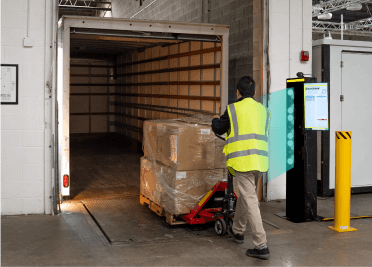Like healthcare providers, retailers and their supply chain partners are working hard to prevent the spread of COVID-19 right now by implementing several new social distancing and operational safety measures in their warehouses and stores, including strict hand washing and device cleaning protocols as recommended by global and local officials. However, some health experts have expressed concerns that typically-airborne pathogens such as COVID-19 could land on and temporarily live on surfaces such as plastics, including those found on the barcode scanners widely used by workers in production facilities, warehouses and stores. As such, proper cleaning of these surfaces is even more imperative.
Given how furiously that store associates, warehouse workers and others are working to fill customer orders and restock shelves, it can be challenging to stop and clean barcode scanners as frequently and thoroughly as recommended right now.
As a result, many retailers have been asking if they should start buying healthcare-grade barcode scanners to give to these workers instead of the models traditionally used in retail and warehousing environments. They heard that healthcare scanners offer more protection against the spread of pathogens and that some even have special antimicrobial additives in their plastic components that can kill any microorganisms that might make their way onto the devices, or at least stop their growth. They reached out to us to see if there was any merit in these claims.
To help sort facts from fiction, two scanning technology experts, Amanda Barkan and Greg Carras, were asked to confirm whether or not there are benefits to using scanners with antimicrobial additives and if retailers should indeed be using healthcare-grade scanners in their stores or warehouses right now given that these devices are shared among shift workers who are preparing customer orders.
###
Blog Team: Tell us, is there a way for retailers to help control the spread of viruses such as COVID-19 by simply using healthcare-grade barcode scanners in stores and warehouses instead of their current scanners?
Amanda: I know there are products out there claiming that some scanners’ antimicrobial housings effectively mitigate the spread of germs and virus strains. And there is evidence that antimicrobial additives can prevent the growth of microbes on the surface of the scanner itself. But that does not mean that the scanner is automatically “clean” all the time.
Even Microban, one of the largest suppliers of antimicrobial technologies, emphasizes on its website that its “built-in antimicrobial technologies are effective against a plethora of product damaging microbes but are not currently proven to have any antiviral properties when built into products. The active technology itself may be effective against viruses in pure state, but not when incorporated into a product.”
The last thing that anyone – especially a device manufacturer or retailer – should do right now is create a false sense of security among their workforce about the cleanliness of scanners. Antimicrobial additives do not kill the microbes already on the scanner. In addition, the effectiveness of antimicrobial additives decreases over time. So, it would be risky and irresponsible to say that anyone using a healthcare-grade scanner or scanner with antimicrobial additives could safely reduce the amount of attention being given to cleaning these shared devices right now.
Blog Team: So, bottom line, there is no “magic bullet” in barcode scanners that have antimicrobial additives?
Amanda: No. All barcode scanners, regardless of their product design or intended use, need to be thoroughly and frequently disinfected using the guidance provided by the device manufacturer.
Greg: One thing to remember is that there are strict governmental regulations about the claims that can be made about the efficacy of antimicrobial agents in plastics. That is why product disclaimers often say that they have “disinfectant-ready enclosures treated with antimicrobial additives that can help fight against the spreading of germs.”
Blog Team: Can you explain the benefit of antimicrobial agents then? Why do some scanner manufacturers add them to devices intended for use in healthcare environments?
Amanda: Per Microban, “there are a number of ‘antimicrobial’ definitions that vary depending on use, function, production, regulations and benefits. However, in broad terms, antimicrobial describes a substance that can destroy or inhibit the growth and development of microorganisms, including pathogenic bacteria. Antimicrobials will typically be based on active ingredients like silver, ion or zinc.” Antimicrobial additives refer to the specific active ingredients that are engineered into products during the manufacturing process.
The reasons why they are added to products also varies by manufacturer. I can’t speak for others’ design decisions. However, when it comes to barcode scanners, Zebra has not found the addition of antimicrobial agents to provide a significant advantage over traditional device cleaning practices. It remains necessary to thoroughly and frequently clean all devices since the efficacy of antimicrobial agents to help prevent the spread of COVID-19 and other viruses is still not well demonstrated, and their effectiveness in slowing the spread of other pathogens is reduced over time.
Blog Team: So, in your opinion, there is no scenario in which retailers or their supply chain partners should consider giving workers a barcode scanner that is purpose built specifically for healthcare applications?
Greg: One thing that we have been reminding customers recently is that general purpose barcode scanners provide a variety of unique advantages for retailers that won’t be found in a healthcare scanner, because they were designed specifically with retailers in mind. One of them is the increased decode range for scanning heavy items in the bottom of a shopping cart, without having to leave the cash wrap. This enables store associates to keep a safer distance from shoppers and reduce handling of customers’ items.
Now, there may be a benefit to using healthcare scanners in a retail pharmacy due to their higher density scanning capabilities for individual medications. However, that decision should be made based on workflow appropriateness and not necessarily infection-control capabilities since all scanners need to be cleaned at frequent intervals to mitigate the spread of viruses.
Blog Team: Are there other safety advantages to sticking with general purpose barcode scanners in retail stores? Or would you say the advantages come in greater operational efficiency?
Greg: Both, actually. The scanners that some retailers have in stores today are designed to parse driver’s license data for age verification and/or loyalty applications at the point of sale in a contactless manner, which is important right now. Shoppers can simply show their driver’s license or mobile loyalty barcode on their phone without having to hand it over to the associate to scan.
Plus, the Digimarc digital watermark technology built into these scanners enables workers to scan invisible barcodes located anywhere on a package, even if the standard UPC barcode is on the other side. This equates to less handling of items trying to locate a barcode, which is important given that COVID-19 and other viral contagions could be spread via cardboard and other packaging materials.
Blog Team: Is there any harm in using a healthcare-grade scanner in a retail environment?
Greg: No, there isn’t any harm, but there may be tradeoffs given the unique advantages that retail scanners offer, as previously mentioned. Retailers are busy enough as it is right now trying to keep their operations running seamlessly. There’s no need to switch out barcode scanners as a preventive measure, especially if they are enforcing strict device cleaning protocols already.
Blog Team: Is the cleaning protocol the same for both general purpose and healthcare barcode scanners?
Amanda: That will depend on the manufacturer. The disinfectant-ready housing of some of Zebra’s healthcare scanners, for example, are designed with virtually seamless plastics. And you won’t find any speaker holes or exposed screws since the goal is to mitigate the aggregation of dirt and germs and provide maximum protection against the spread of infection around patients. As a result, Zebra’s healthcare-grade barcode scanners can be safely wiped down with up to 36 approved disinfectants, many of which are far stronger than your typical household disinfecting wipe.
That said, Zebra’s general purpose scanners can actually be cleaned using Isopropyl Alcohol 70%, to help keep workers and customers safe. That’s a huge bonus for retailers who have general purpose scanners widely deployed.
Blog Team: Is there anything else that retailers and their suppliers should look for when implementing new scanning technology in response to growing operational demands?
Greg: Right now, essential businesses are prioritizing two things: safety and efficiency. We’ve already talked about how to keep devices clean to help control the spread of contagions. But don’t forget about the ancillary technologies and accessories. For example, these scanners are likely being used around the clock right now to pick, pack and deliver customer orders and replenish inventory. That means that battery life and fast recharging capabilities are critical considerations. I recommend choosing a scanner that can last multiple shifts before needing to be recharged. Cordless scanners that last multiple shifts on a single charge both improve productivity and help minimize the number of associates who are coming in contact with the scanner or shared recharging resources.
Amanda: I always remind customers to assess overall scanner performance and management requirements as well as durability ratings. Having a scan engine that can read damaged, dirty or otherwise problematic barcodes on the first trigger pull is always mission critical, but even more so when workers are moving at record speeds to keep inventory moving from the warehouse to store shelves or customers’ doorsteps.
You also have to remember that barcode scanners – like handheld mobile computers or tablets – need to be configured and managed. Having the ability to do so in a contactless manner can pay dividends given many organizations’ dispersed operations and more recent efforts to maintain social distancing among workers. Make sure you’ll be able to remotely set scanning parameters, update firmware and make other changes as needed so that you don’t have to deploy support teams or additional associates on site. And remember to test the scanners’ ability to operate on Wi-Fi networks without interference. The last thing you want is for them to disrupt network performance or fail to reliably connect to back-end inventory or order systems.
After all, the COVID-19 outbreak will eventually subside and operations should stabilize. Though certain process changes and technology investments must be made to overcome immediate and unpredictable challenges, I believe it’s critical that such actions first be assessed under a “future-relevant” lens. Will the barcode scanners you deploy this week, month or even year to help you get through these hard times be able to fully support your business needs as they evolve in the years to come? That is the question that retailers should be asking right now when deciding which scanners are right for their business in the short and long term.
###
If you are currently evaluating barcode scanners for use in your retail, warehousing or distribution environment and have more questions for AbeTech Solution Experts, please contact us here. We’re happy to help in any way we can.
#ZebraPartner










